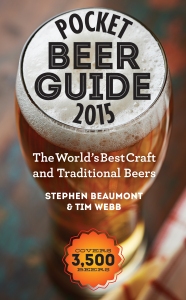 The new edition of my and Tim Webb’s Pocket Beer Guide, officially titled Pocket Beer Guide 2015, is out next month, and as per my recent habit, I’ll be taking to the road to do a bit of promotion. Here’s the schedule:
The new edition of my and Tim Webb’s Pocket Beer Guide, officially titled Pocket Beer Guide 2015, is out next month, and as per my recent habit, I’ll be taking to the road to do a bit of promotion. Here’s the schedule:
September 30, Seattle, WA: I’ll be signing books and sipping rare beers at the new Toronado Seattle, 1205 NE 65th Street (at the corner of 12th Ave), all night long. Drop by to say hi, share a beer and maybe even buy a book! (NOTE added 9/29: Unfortunately, books will not be available in time for this event. If you want to come out and chat beer for a while, though, I’ll still be drinking at the Toronado. Look for me or ask the bartender!)
October 1, Denver, CO: In my first ever appearance at a cabaret venue (!), I’ll be onstage with Charlie Papazian, Green Flash’s Chuck Silva, our host Marty Jones, plus several bands and burlesque dancers at Marty Jones Brew Night Show. Frankly, I’m not entirely sure what will be happening, but I’ve known Marty for a number of years so I’m sure it’s going to be fun, and there will be great beer, too.
October 2 – 4, Denver, CO: I’ll be signing copies of the new book plus a few older ones in the Bookstore at the Great American Beer Festival. Check here for times.
October 5, Nashville, TN: I’ll be hosting a very special, 5-course beer dinner at the Nashville location of the Flying Saucer. At a mere $45, and with the beers and food we’ve got planned, it’s a bargain and a half!
October 6, Austin, TX: Another Flying Saucer appearance sees me in charge of what they’re calling a “Brewer’s Summit,” featuring Real Ale, Jester King, Austin Beerworks, Thirsty Planet and Karbauch. Taste beer, eat food, listen to me talk about the beers the brewers bring, and hear them tell me why I’m wrong. What’s not to like?
October 7, Garland, TX: The Flying Saucer again, and another “Brewer’s Summit,” this time with Rahr & Sons, Real Ale, Sierra Nevada and Founders Brewing. Worth it just for the opportunity to sample great beers in an idyllic setting on Lake Ray Hubbard.
October 8, Addison, TX: I admit to being a little nervous about hosting a beer dinner in what the Addison Flying Saucer people call the “Pub of Love,” but the menu and beers look great and I’m assured that the setting will be cozy and, dare I say it?, intimate.
October 9, Fort Worth, TX: This is going to be a fun one! Taking a break from the tour’s all-beer theme, I’ll be hosting a beer, wine and spirits dinner in the Bird Café, located where the original Fort Worth Saucer used to be, collaborating once again with ex-Meddlesome Moth chef David McMillan. The menu looks spectacular!
October 10, Fort Worth, TX: Another Flying Saucer and another “Brewer’s Summit,” this time with Rahr & Sons, Community Brewing, Lakewood Brewing, Revolver Brewing and Martin House Brewing. Keith Schlabs, the head beer wrangler for the Flying Saucer group, assures me that all the brewers have promised to bring their “crown jewels,” so this should be a tasting for the books!
October 11, Fort Worth, TX: I’ll be taking things a bit easy on the last day of my tour, if you can call attending the Flying Saucer’s 9th Annual BeerFeast “taking it easy.” I’ll have books available for signing and look forward to some casual chatting about beer.
Sometime in October: Once I’m back in Toronto and sufficiently recovered, I’ll be hosting a book launch event in the city’s downtown. Stay tuned for date and details.

 was that at least some of the beers I’d be sampling would stand up to serious critique.
was that at least some of the beers I’d be sampling would stand up to serious critique. About a year later, already entranced by these new tastes, I discovered another Belgian ale. This one came from a tiny, five-year-old brewery in the Ardennes, Belgium’s densely forested southeast, and sported an easily identifiable label featuring a curious gnome. It was called La Chouffe.
About a year later, already entranced by these new tastes, I discovered another Belgian ale. This one came from a tiny, five-year-old brewery in the Ardennes, Belgium’s densely forested southeast, and sported an easily identifiable label featuring a curious gnome. It was called La Chouffe. I’m not even going to feign impartiality when it comes to reviewing
I’m not even going to feign impartiality when it comes to reviewing  A couple of months ago, I received a preview copy of the galleys of
A couple of months ago, I received a preview copy of the galleys of 
